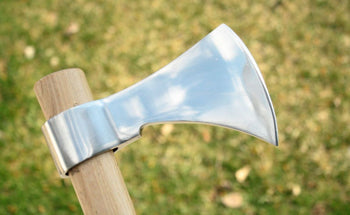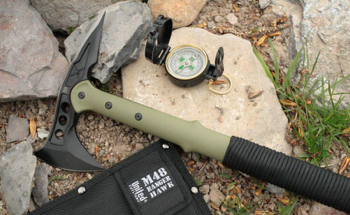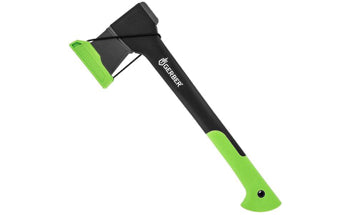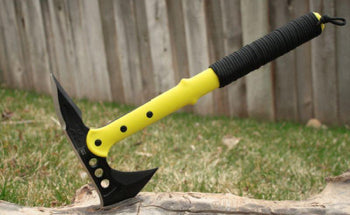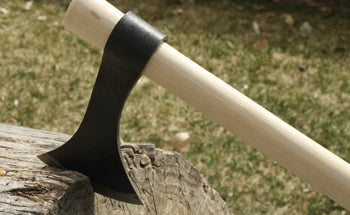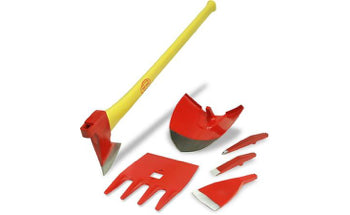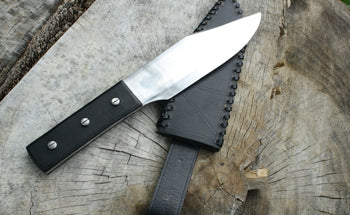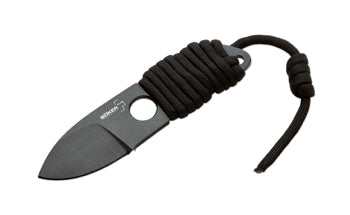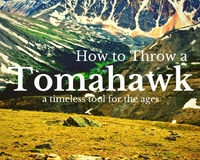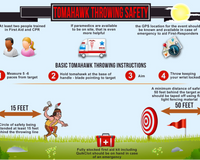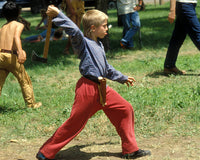 Tomahawk throwing is one of America's oldest pastimes dating to the Colonial Period. Settlers, pioneers, mountain men and Native Americans enjoyed this unique activity and developed their own sets of rules and challenges for each event. From throwing multiple axes from given points to splitting a musket's bullet on the head of an axe; tomahawk throwing has endured throughout the ages.
Tomahawk throwing is one of America's oldest pastimes dating to the Colonial Period. Settlers, pioneers, mountain men and Native Americans enjoyed this unique activity and developed their own sets of rules and challenges for each event. From throwing multiple axes from given points to splitting a musket's bullet on the head of an axe; tomahawk throwing has endured throughout the ages.
Organizing a tomahawk throwing competition in the 21st century can be done successfully if the coordinator prepares in advance and keeps safety in mind for the benefit of the participants and the spectators. Prepare yourself by getting the Best Competition Throwing Tomahawk!
Throwing Range
As with any activity involving hurling a potentially dangerous weapon toward a target, the actual throwing area must be kept safe. A minimum distance of safety of 50 feet behind the target area should be taped off using flags, light fencing material or a combination of these to keep people from inadvertently walking into the impact area or beaten zone in case a tomahawk misses its target.
This safety area should extend from the target area to the throw line to keep spectators out of harm's way, with an additional circle of safety being extended at least 15 feet behind the throwing line.
At least one fully stocked first aid kit including QuikClot should be on hand in case of an emergency as well as at least two people trained in First Aid and CPR. If paramedics are available to be on site, that is even more helpful. For competitions in rural and remote locations, the GPS location for the event should be known and available in case of emergency to aid First-Responders in arriving at the location.
Target Types
 Traditional tomahawk target boards are usually made from sections of tree trunks with a minimum diameter of 12 inches. Substitute targets can be made from planks of lumber of soft wood. The recommended thickness of either target should be at least 4 inches to prevent destruction of the target during use.
Traditional tomahawk target boards are usually made from sections of tree trunks with a minimum diameter of 12 inches. Substitute targets can be made from planks of lumber of soft wood. The recommended thickness of either target should be at least 4 inches to prevent destruction of the target during use.
The targets can either be painted directly onto the target boards or bull’s eye targets sold for firearms or archery use may be attached. The ideal center bull's eye should be a 3-inch diameter circle with outer concentric rings spaced every 2 inches. For consistency if no suitable targets can be purchased, these targets can be drawn or previously printed on paper or large paper-plates.
A good rule of thumb is to have more target boards and targets on hand than potentially needed in the event that these may be destroyed during competition.
Targets should be evenly spaced at least ten feet apart from each other to help prevent throwers from hitting their neighbor’s targets.
Safety Throwing Line
The throw line is where the participants will actually throw their tomahawks at the target and the line should be visibly marked by either a marking spray paint used for outdoor sporting fields or a long length of rope. Throwers may be penalized for stepping over this line as it is a potential safety hazard.
The throw line may be static for the event or mobile. A static throw line means that all tomahawks are thrown from the same distance. A mobile throw line allows for the participants to move to other fixed points further away from the target. For example, after all the tomahawks are thrown at 10 feet, the participants move back to the 15 foot line and then the 20 foot line. Advanced adult competitors can throw at distances up to 30 feet. Each of those throw lines should be marked prior to the event.
The Right Tomahawks
Tomahawks for throwing should have the following characteristics:
- A minimum handle length of 12” not to exceed 24”
- A maximum cutting edge of 4.5”
- An unsharpened edge for safety, what makes the tomahawk stick in the target is blade geometry and force of the throw
- One piece hawks fitting these dimensions may be allowed at the discretion of the host
For more on selecting the right tomahawk for your age, height, and strength visit our best tomahawk for you page. Our best selling competition tomahawk is the is found by clicking here.
Scoring the Competition
Scoring is dependent on the number of tomahawks thrown and where the tomahawk strikes the target. Scores can be based on an arbitrary number assigned to each position on the target as well as the actual target which is struck in sequence.
A hawk striking a target out of sequence can cost the thrower a point. Multiple hits on a single target when more than one is used should be scored as a miss. A good example would be a target position holding 5 targets for a single thrower with two on the left, one in the center and two on the right.
The thrower should be instructed to hit these targets in a particular sequence such as: top left, bottom left, center, bottom right and top right. Any hits deviating from this order should be scored as a miss. Building on this example, a hit on the bull’s eye should be scored as 5 points; the next ring should be given a 4; the outermost ring a 3 and outside this ring, but still on the target, as a 1. Hits which impact the board are scored as 0. In the event that the tomahawk lands on a ring between 2 values, the score should be for the higher value. This would make for a high score of 25 for this position. Scores can be increased by a point for the next stage if the distance is increased and so on.
Basic Throwing Steps
 The tomahawk should be grasped at the end of the handle farthest away from the head of the tomahawk. The thrower should face the target with the feet positioned in a manner where the foot opposite the throwing hand is forward.
The tomahawk should be grasped at the end of the handle farthest away from the head of the tomahawk. The thrower should face the target with the feet positioned in a manner where the foot opposite the throwing hand is forward.
From this position, the tomahawk is brought up and back by cocking the elbow while facing the target. The tomahawk will rotate in the air as it is thrown and the distance will determine the number of times it will completely spin.
This can be dependent upon the size and strength of the thrower and the thrower should be allowed to move a few feet rearward of the throw line to compensate for this, but never forward of the line. For more on how to throw a tomahawk visit our tomahawk throwing how to page.
Summary
Organizing a tomahawk competition requires a significant amount of planning; from assigning scores to building targets to keeping the participants and spectators safe. Whether the event is designed for the Boy Scouts of America, a Mountain Man Rendezvous, or even a backyard competition; adhering to the basics detailed within will make for a safe, productive and fun competition for all involved. More on tomahawk throwing & competitions found here.
Note: We were asked to write a guest post for Scouting Magazine's blog on how to safely introduce tomahawk throwing to your next Boy Scouts of America activity. If you are a Boy Scout leader and would like to view this article you can find it by clicking here.
